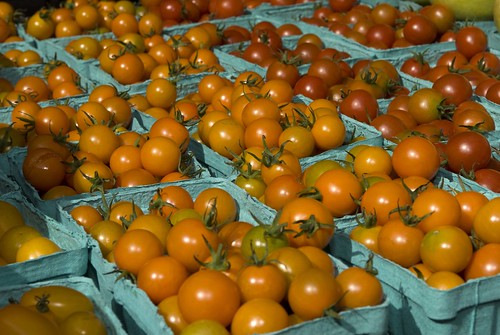Inside The New York Botanical Garden
heirloom tomatoes
Posted in Gardening Tips on August 3 2009, by Sonia Uyterhoeven
 |
Sonia Uyterhoeven is Gardener for Public Education. Join her each weekend for home gardening demonstrations on a variety of topics in the Home Gardening Center. |
 Tomatoes originated in the Andes Mountains of Peru, where eight different species of tomatoes still grow in the wild. They were first brought to Central America and domesticated by the Aztec, who grew a yellow form of the cherry tomato (Lycopersicon cerasiforme) that they mixed with peppers and salt to create the first salsas.
Tomatoes originated in the Andes Mountains of Peru, where eight different species of tomatoes still grow in the wild. They were first brought to Central America and domesticated by the Aztec, who grew a yellow form of the cherry tomato (Lycopersicon cerasiforme) that they mixed with peppers and salt to create the first salsas.
The Aztec named these little fruits xitomatl, which translates into “plump little thing with a navel.” Subsequent Central American tribes renamed the fruit tomati It was brought to Europe by Spanish and Italian explorers, including Hernando Cortez and Christopher Columbus.
When the tomato first arrived in Europe it was viewed with suspicion. Tomatoes are members of the nightshade family (Solanaceae), and their foliage is similar to deadly nightshade (Atropus belladonna), which was a well-known poisonous plant used as a hallucinogenic drug and a beauty aid. It was fashionable in medieval courts for women to dilate their pupils with drops made from the plant. When taken as a hallucinogen, the drug induced visions and a feeling of flying that were associated with the practice of witchcraft.
To make matters worse, the upperclass ate off of pewter plates that contained a high lead content. Tomatoes, being high in acid, would cause the lead to leach out, resulting in lead poisoning. The first tomatoes, renamed pomi d’oro or golden apple by the Italians, where thought to be inedible; they were viewed as ornamental plants. Only the poor, who ate off of wooden plates, consumed the fruits.
Read More
Posted in Shop/Book Reviews, The Edible Garden on July 15 2009, by Plant Talk
 |
Richard Pickett is Director of Retail Operations. |
At your next family reunion picnic you may run into some long lost relatives. Perhaps you’d think distant cousins, twice removed on your mother’s side, but in fact Lazy Housewife, Radiator Charlie, and Collective Farm Woman are beans, tomatoes and melons, respectively, more likely to be found on your plate next to grandma’s famous potato salad than out back bobbing for apples or spitting watermelon seeds.
By definition, heirloom vegetables are vintage varieties that have been preserved by passing seeds down from generation to generation. Heirlooms have often been selected for taste, appearance, and eating quality, and the demand for heirloom vegetables is rapidly increasing, especially among gardeners looking for unique flavors and freshness. While many heirloom vegetables are now available at farm stands, varieties of tomatoes, beans, and cucumbers are the most popular.
Among edible heirlooms literally thousands of varieties are available, many handed down, others swapped with fellow gardeners, and a growing number purchased from the ever-expanding selection of specialty seed purveyors. For The Edible Garden, the Home Gardening Center’s Lois Loeb Vegetable Garden has been redesigned by Rosalind Creasy into New York’s best heirloom vegetable garden. Using seeds from Seed Savers Exchange, this garden features a bountiful array of beautiful and delicious heirloom vegetables, herbs, and edible flowers. Seed Savers Exchange is the foremost organization dedicated to preserving agricultural diversity through the preservation and sharing of heirloom seeds.
At Shop in the Garden, we offer a wide variety of heirloom seeds, exclusively from Seed Savers Exchange, as well a great selection of heirloom tomato, pepper, and eggplant seedlings. You can also find fabulous garden gear online. So whether you are a longtime heirloom vegetable advocate (and there are many) or simply a home gardener looking for more variety, flavor, and excitement in your harvest basket, give heirloom vegetables a try. Who knows, in our hectic day-to-day existence, it may just be time to find the Lazy Housewife in all of us.

 Tomatoes originated in the Andes Mountains of Peru, where eight different species of tomatoes still grow in the wild. They were first brought to Central America and domesticated by the Aztec, who grew a yellow form of the cherry tomato (Lycopersicon cerasiforme) that they mixed with peppers and salt to create the first salsas.
Tomatoes originated in the Andes Mountains of Peru, where eight different species of tomatoes still grow in the wild. They were first brought to Central America and domesticated by the Aztec, who grew a yellow form of the cherry tomato (Lycopersicon cerasiforme) that they mixed with peppers and salt to create the first salsas. 
